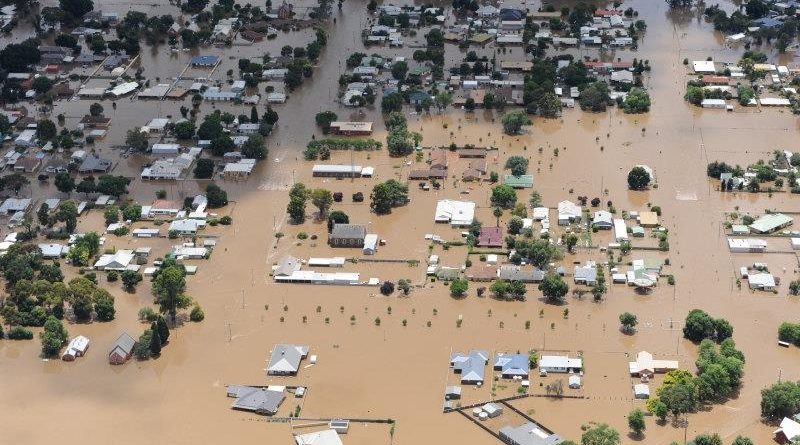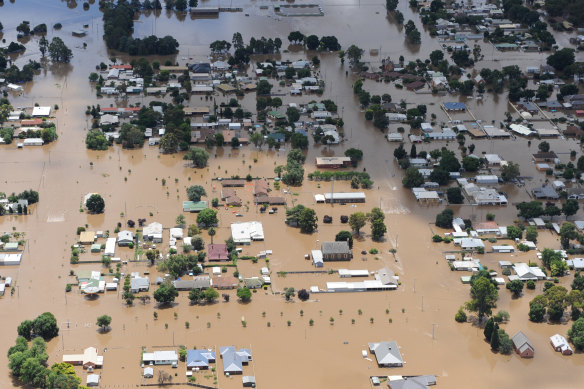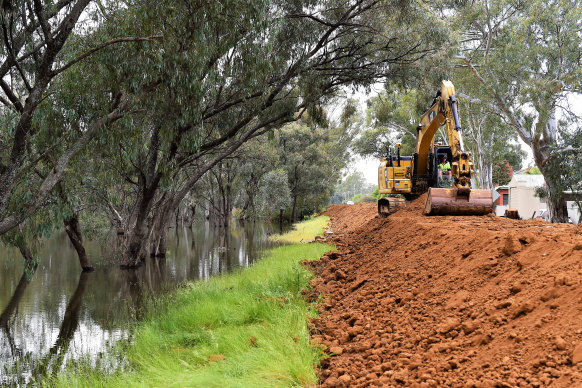‘Playing Russian roulette’: why development continues in flood zones
Key points
- Planning provisions require local councils to consider flood risks when preparing planning schemes.
- However a scarcity of up to date data and flood mapping and an approach which relies on local councils and catchment management authorities means development continues on flood plains.
- The federal government is considering land buybacks while the state government has promised a $351 million package to help flood-affected communities.
Ask Wayne McKail if people should be building in Carisbrook’s flood plains and his answer is unequivocal.
“Goodness no,” he says.
Carisbrook sits at the intersection of the Tullaroop and McCallum creeks and the central Victorian town was devastated by the floods of 2011. Residents were relieved this week to narrowly avoid major flooding.
The town of Carisbrook during the catastrophic floods of January 2011.Credit:Jim Aldersey
“We really avoided the bullet, and we were really, really lucky with that,” McKail says. “The river level got up to about five metres, which was enough for it to just flood a couple of houses, and it did not get into the town.”
In Carisbrook, as in many areas around the state, residential construction is powering ahead on flood-prone land. A new subdivision in the town now includes several houses right next to a creek.
Development on flood-prone land is highly divisive. But the issue has been thrown into sharp relief as devastating floods swept Victoria this week, claiming two lives and inundating thousands of homes. Flood warnings still remain in place across much of the state.
Even as this disaster unfolds, governments and planners are asking whether too much residential construction is being allowed in flood-prone areas. And if property owners have been inundated repeatedly, should governments pay them to leave?
Planning provisions require local councils to consider flood risks when preparing planning schemes.
If a proposed development is in a flood zone or overlay, a planning permit is required for subdivision or works and this triggers a referral to the local catchment management authority, which can object, approve or approve with conditions.
However, groups including the Planning Institute of Australia, the Insurance Council of Australia and risk analysis firm Climate Risk warn councils and homeowners are using outdated data and flood mapping and there is no unified approach across the state.
McKail, president of the Central Goldfields Ratepayers and Residents Association, says while Carisbrook has a history of flooding, some protection has been afforded to the town by a levee being built by the local council.
“If it works it should protect the area that they are developing on, but at the moment it is still a huge bone of contention as to whether it will operate adequately,” McKail says. “If the levee works it will not be an area subject to inundation, but if it doesn’t work [the new homes] will end up in the creek.”
Despite Carisbrook’s potential to flood, the Central Goldfields Shire has designated the small town of about 1000 residents a growth area for the region.
Mayor Chris Meddows-Taylor insists development should continue in Carisbrook, “but with the authorities taking proper due diligence to ensure that the areas for development are the best … and the building requirements are such that flood mitigation is a primary concern”.
“We do want to grow Carisbrook, but we want to grow it safely,” he says.
Meddows-Taylor hopes Carisbrook’s levee will provide added protection but warns “the levee is not about flood prevention – we can’t prevent, we can mitigate … the best-constructed levee cannot avoid the geography of the situation”.
Experts say there are two types of levees: those that have failed and those that will fail.
Brian Cook, associate professor at the University of Melbourne, warns building levees is not a long-term solution to flooding, and they bring a “false sense of security”.
He refers to the flood risk management concept known as the “levee effect”, where people feel more secure knowing a levee is nearby and so developers build further into flood plains. When the levee breaks, more development is exposed and the damages are magnified.
“We have economic incentives all throughout the system that encourage us to say ‘Hey, we can protect this little parcel of land near the river’, rather than ‘Hey, maybe we shouldn’t build there, maybe we should build up on this hill, a little way away from the river’,” Cook says.
He says it is difficult to stop developing flood-prone land as Australians love to live near water and flood-prone land is often more affordable, enabling developers to generate more profits and councils to collect more rates.
“We allow a system to go on where the people who profit from creating the risk aren’t held accountable in any way, shape or form and largely they’re protected by existing policies and practices, despite the fact that we can draw a very clear line between their profit-making actions and the production of risk,” he says.
Flood risk in Australia is assessed using a “100-year flood event” line, which defines land with a 1 per cent chance of experiencing a flood each year.
With the impact of climate change already being felt through increasing extreme weather events, this line is changing rapidly.
Cook says there is no need for Australia to continue new developments on flood-prone land, and we should instead be intensifying existing developments.
“There’s really no need for us to go into high-risk locations any further,” he says. “We’re already well past the 1 per cent line and to go any further is just begging for the creation of even more and more damaging floods.”
Risk analysis firm Climate Valuation published a list earlier this year identifying the areas with the most properties at risk from the impact of climate change in the state.
Shepparton tops the list, with 16255 properties slated to be at risk of riverine flooding by 2050, followed by Wangaratta, Port Melbourne, Kialla, Horsham, Mildura, South Yarra, South Melbourne, Kensington and Echuca.
Chief executive Karl Mallon says tough conversations are necessary with flood-affected residents likely to be in situations where they won’t be able to afford inflated insurance costs.
“That cohort who are playing Russian roulette with the weather is just going to get bigger,” he says. “Then the next thing we’ll see is properties decrease in value.”
In Queensland, the state and federal governments have already begun buying flood-prone properties from homeowners in recognition that those areas will almost certainly flood again soon, with 25 buyback offers accepted in the Ipswich City Council area and nine in Brisbane.
Last week, Federal Emergency Management Minister Murray Watt said a further 41 offers had been made to eligible homeowners. More offers are likely in other areas and hundreds of people in Queensland have registered a preference for the voluntary home buyback program.
Minister for Emergency Management Murray Watt said buybacks would be considered for Victoria.Credit:Alex Ellinghausen
This week Watt told The Age his government would consider a buyback scheme for Victoria, once the current emergency subsides.
“It’s probably a little early to know whether something like that is going to be required in Victoria,” he says. “But I’m open to those discussions with the Victorian government once we get through this immediate crisis.”
He says the buyback schemes in Queensland and New South Wales targeted areas hit by repeated flooding within a few years.
Watt believes these buybacks can save taxpayers’ money while easing the emotional toll of environmental disasters.
“If we as a community can save our fellow community members from that heartache, that’s a good thing. But also from an economic point of view we all as taxpayers have to fork out billions of dollars far too often for these events.
“And if there’s a way of saving the budget bottom line in the future by undertaking these kinds of buyback programs then it makes good economic sense as well.”
Watt flagged the government’s intention to take a more active part in residential planning for disaster mitigation, although he conceded the Commonwealth had few “policy levers” in this area.
“It may be that we use Commonwealth funding to incentivise good planning and development decisions, rather than simply be used as a bank to pay for fixing up the consequences of bad decisions in the past.”
A spokeswoman for the Victorian government declined to comment on whether the government would consider buybacks of flood-affected land.
“We’re focused on our emergency flood response, which is still underway, and are doing everything we can to ensure the safety of Victorians,” she said. “We’re delivering a $351 million package to help flood-affected communities get back on their feet and will continue speaking with communities about their immediate and future needs.”
She said the government has contributed $47.7 million in funding flood studies with 84 flood studies funded, of which 58 have been completed.
“We know extreme weather events are becoming more frequent and severe, that’s why we legislated the Climate Change Act 2017 to ensure our decisions take climate change into account,” she added.
However Andrew Hall, chief executive of the Insurance Council of Australia, says a mindset shift needs to happen in government from short-term fixes to long-term solutions.
“They make a lot of announcements when a flood happens immediately,” he says. “There’s hundreds of millions of dollars to repair the roads and household grants and the like, all of which is very important.
A levee being constructed in Echuca this week.Credit:Steve Huntley/Riverine Herald
“But the real announcement that has to be made is ’Here is the $1 billion now to either raise a levee around Echuca or to move the homes that are going to be flooded, to recognise Shepparton as a significant economic centre for Victoria and protect it.”
Hall says many owners of the homes that have been flooded in Victoria had already opted out of flood insurance because it was so expensive.
“We get made aware frequently of new developments where you have a look on the map, and you then go and try to quote for insurance and the prices are coming back and they’re not able to be quoted or they are very high, because they’re in higher-risk flood zones,” he says. “These mistakes are continuing to be made.”
Hall says development continues in flood zones because of the demand for affordable housing in Australia. “Affordable housing generally emerges in areas where the land is very cheap and there is a reason why the land is cheap,” he says.
The Insurance Council wants to see up-to-date data provided to homebuyers, so they know the perils of the property they are buying.
“Making that really accessible in the homebuying process will I think adjust the market as to properties’ true value,” he says. “If you can’t afford insurance for the property you buy, you likely would be in default of any mortgage you would have.”
Jane Keddie, vice-president of the Planning Institute of Australia’s Victorian division, is also concerned about the lack of data and says while there is clear policy direction to avoid development in flood-prone areas, the challenge is in the application of that policy.
“It is fair to say that we certainly don’t in practice avoid all development on flood plains,” she says. “To say we shouldn’t have any development in any areas subject to risk is probably not achievable, that is why we have placed an emphasis on having a really good understanding of what those risks are.”
Keddie says the state government must give clear direction as to when the risk of flooding is at a level which precludes further development.
“We need clearer guidance on what is an unacceptable level of risk and where we want to avoid development and where a built form response is appropriate,” she says.
What the experts, residents and government agree on is that significant numbers of homes in Victoria have already been built on flood plains and the extreme weather the state is experiencing is only going to increase.
In Carisbrook, residential construction continues apace. Locals can only hope the levee is finished and holds when the next flood arrives.
Most Viewed in National
From our partners
Source: Read Full Article







